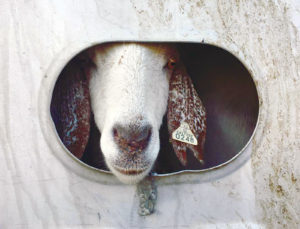“The rangelands in the Bay Area are incredibly important for wildlife and native plants. They provide the landscape connectivity that species need to move from place to place, which is especially critical in a time of rapidly changing climate.”
Dr. Reed Noss, former president of the Society for Conservation Biology
At the Yolo Land and Cattle Company, some 80 miles northeast of San Francisco, along the eastern base of the blue-green massif known as Blue Ridge, butterflies and cattle move across a blond sunbaked plain on a warm summer day. There are swallowtails, sulphurs, skippers, and a herd of ebony Angus cattle. A swallowtail flickers across an empty chair, wing dots dancing, right “where Hank used to sit, right there, where the breeze blows through every day like clockwork,” says Karen Stone, a petite brunette of Italian descent who owns and manages the 13,000-acre operation with her husband, Scott, along with Scott’s brother Casey and his wife Angela.
“Hank” is father-in-law Hank Stone, who passed away at 84 last year. His presence in California’s agricultural community was legendary, and there is a lingering sense of loss, the feeling that he was in his prime, happy to wake up every day with so much more to do. One of the projects he was most proud of is a conservation easement he worked out with the California Rangeland Trust to protect his beloved ranch forever by prohibiting future development.
Hank was an alliance builder, willing and able to work with all kinds of people. Karen and Scott continue that tradition. Nine years ago, Audubon California approached the Stones because the group’s biologists had identified a problem: Suitable habitat for overwintering waterfowl was being lost to development. The Stones’ work on restoring riparian areas had already helped neotropical migrant songbirds. Would they help out overwintering waterfowl by enhancing the habitat of one of their stock ponds? With funding from private and public partners, the Stones restored a large pond and added a hand-carpentered goose-nesting platform. Now they’re partnering with the nonprofit Point Blue Conservation Science to monitor and evaluate the results of their efforts in terms of both bird and plant diversity. They’ve also been part of scientific field trials involving rangeland carbon sequestration. And they use recycled rinse water from a nearby Campbell soup cannery to irrigate their pastures. So for people who are looking at the whole picture of Bay Area ecology, the Stones and other ranchers like them are not just stewards of their ranches; they’re also “value-added” stewards of a significant component of the Bay Area environment—rangelands—that makes up more than 40 percent of the open space in this metropolitan region.

BAD COW, GOOD COW
So if ranchers are such great conservation partners, why has ranching often been viewed as bad for the environment? Part of the answer lies in the history of ranching in the state. The Spanish colonists who first introduced ranching to California in the late 1700s also introduced nonnative annual grasses that outcompeted the native perennial grasses and led to a severe loss in biodiversity. And in the decades that followed, incidences of poor range management — overstocking and overgrazing — resulted in soil compaction, erosion, and mismanagement of riparian and wetland areas that reduced habitat for bird species and aquatic life. So vivid were the results of such mismanagement that it became difficult for the environmental community to see the benefits of good management. Any grazing, well-managed or not, was viewed as the antithesis of good environmental stewardship.
The environmentalist perspective was that to get the benefits of clean water, wide-open vistas, and healthy wildlife, society needed to set aside open space as public parkland and remove nonnative ungulates (hooved grazing mammals) so the land could heal and return to its native state. But now, after more than a decade of research on the question, it’s becoming clear that well-managed private ranchlands can provide these essential public benefits at little cost to the public, while at the same time ensuring that the land remains economically productive. Chronic underfunding means that public agencies generally lack the resources to properly manage all of this rangeland even if “we, the people” could afford to buy it all, which we can’t.
Sasha Gennet is a senior scientist with the Nature Conservancy of California, which works to assemble and manage large protected landscapes for biodiversity and climate resilience. “Managed rangelands are so important for both natural and human communities,” she says, “from the fresh water that flows off them into creeks and reservoirs to the weed-munching services provided by cattle, which helps keep the wildflowers blooming and the native frogs and salamanders breeding. And keeping ranchers in business means that the land doesn’t end up getting paved over.”

WORST OF TIMES; BEST OF TIMES
Of course, “keeping ranchers in business” in the 21st century is a challenge, particularly in the Bay Area. Real estate values and population growth favor land fragmentation; estate taxes fall hard on land-rich, cash-poor ranchers after the death of family members; cattle prices are subject to the vagaries of a global market; and purchases of former ranches by public agencies can put them off-limits for grazing. And then there’s the current drought and the specter of climate change.
But there is a flip side to this tsunami of challenges. The land trust movement now views protecting ranchlands as essential to large-scale habitat protection, and many land trusts have “working lands” programs. The locavore food movement has spawned a market of consumers interested in eating foods grown close to home in a sustainable way, as well as a new appreciation for the people who are producing that food. And scientists working to address climate change have demonstrated that rangelands sequester greenhouse gas and have the potential to sequester even more when specific management practices are used. At a national level, “carbon offset markets” are in development, so that ranchers who take care of their land and avoid converting it to other uses could potentially receive financial benefits.
This spirit of innovation is spreading, and throughout the region many people involved in land conservation are seeing the upside of integrating privately owned and managed ranches into strategies for preserving biodiversity and open space.
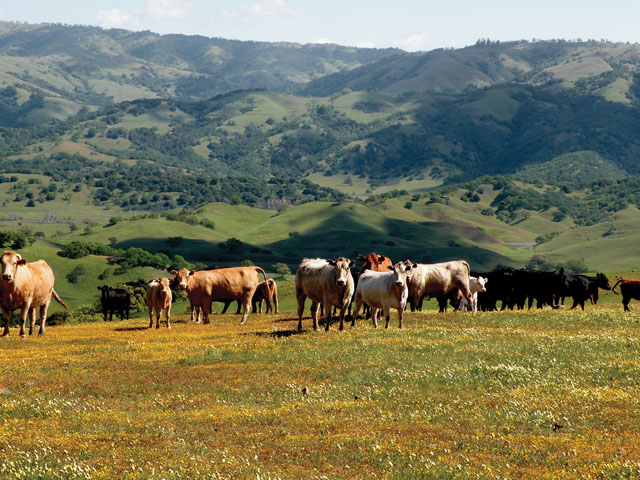
CRITICAL LANDS
In 2011, a consortium of 125 nonprofits, scientists, academics, and public agencies working under the auspices of the Bay Area Open Space Council presented “a vision for the region and how we can work together to preserve biodiversity,” according to council deputy director Annie Burke. The Conservation Lands Network report was, in essence, a blueprint for determining the lands that should be prioritized for protection. Over four million acres were studied, integrating over 1,000 variables, from red-legged frogs to redwood forests to migratory linkages to climate mitigation. When all the data was crunched, rangelands popped up again and again as priority areas for conservation, comprising more than 60 percent of the 1.1 million acres deemed “critical lands” in need of protection. “The report showed us that rangelands support a significant percentage of the biodiversity extant in the Bay Area,” says Burke.
Going deeper, the nonprofit California Rangeland Trust found that approximately 585,000 acres of rangeland in the nine Bay Area counties and Santa Cruz are already protected from development through direct ownership by public agencies and nonprofit land trusts. Another 150,000 are protected under conservation easement, meaning they are privately owned but prohibited from being developed. “The remaining 1.3 million acres are privately owned but provide numerous public benefits,” says Nita Vail, CEO of the trust.

MAMMOTHS AND COWS
Flying over at 30,000 feet, one can easily visualize the Bay Area rangelands’ ancient beginnings. Rangelands dominated the region throughout the Pleistocene, which ended only 10,000 years ago, the mere blink of a geologic eye. In 2005, E. Breck Parkman, a senior ecologist for California State Parks, wrote in a paper entitled “The California Serengeti” that “the African Serengeti [of today] pales in comparison to the [prehistoric] Bay Area in terms of the diversity and density of grazing species in one place.” It was “one of the greatest natural phenomena of all time,” he added. Even the Bay itself was not a bay, but a vast grassy plain with a river cutting through it, emptying into the Pacific Ocean at the continental shelf, near the Farallones. The entire region was so fecund with perennial grasses that it supported and attracted thousands of herbivores, including Columbian mammoths, whose remains continue to pop up in places like downtown San Francisco and suburban San Jose.
Most of the native species that grazed and shaped those Pleistocene rangelands have been gone for millennia, except for deer, tule elk, pronghorn, and the handful of bison in Golden Gate Park. But for the past 200 years, since the arrival of the European settlers, Taurus bos, an ungulate domesticated on the other side of the world 10,500 years ago from wild aurochs, has been the grazer of choice. But cows are a different kind of grazer with different habits than elk or bison. Herds of cattle left on their own can overgraze an area. And yet domestication means that their patterns of movement on a landscape can be guided. And the last 30 years of both conservation biology and range science have made it abundantly clear that while poorly managed cattle can significantly disrupt and harm rangelands, well-managed grazing is an important tool for managing these lands in the absence of the large wild ungulate herds of yesteryear.
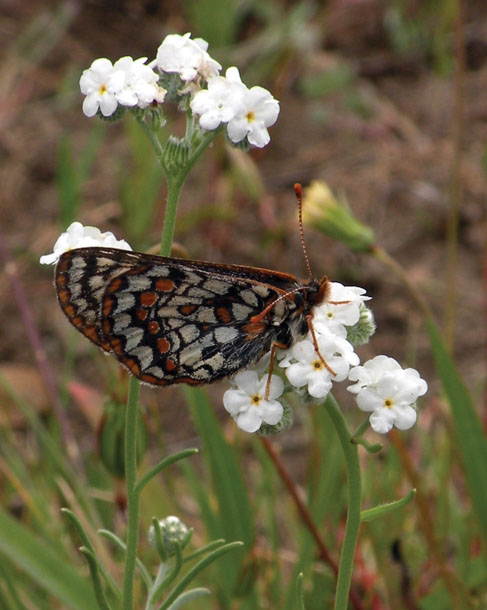
NOT YOUR MOTHER’S RANCHERS
“We try to manage our cattle herd to simulate the large herds of elk and antelope that once roamed California’s grasslands,” says Doniga Markegard, one-half of the husband-and-wife team that runs family-owned Markegard Family Grass-Fed, on the coast side of the Santa Cruz Mountains. She had a background in nature-based education and permaculture, with experience as a wildlife tracker, when she met her husband, Erik Markegard. He is a sixth-generation rancher raised on a 2,000-acre ranch in San Mateo County owned by musician Neil Young, where he learned the ropes by helping his father manage the ranch. After Doniga and Erik got married, they moved on to a nearby ranch on the San Mateo coast where Erik had been raising his own cattle since 1987.
Both Doniga and Erik are keenly attuned to the value of healthy food and healthy landscapes. They guide the grazing of their cows and sheep using movable electric fences to avoid overgrazing and soil erosion, a practice known as holistic management (HM).
Doniga is an eloquent spokesperson for the culture she believes ranching embodies: “the values of family life, open space, and wildlife.” Their children — ages 12, 8, 6, and 4 — all help with ranch operations. Even the youngest can shout up the hill, loud and determined, in just the right way to call in their herd of Belted Galloway and Angus cows.
To an outsider it looks like an impossibly ideal life. But the challenges are formidable. First of all, there’s the challenge of assembling enough pasture to maintain a minimum viable operation. They graze their livestock on some 8,000 acres, but their home ranch (which they don’t own but lease from the Midpeninsula Regional Open Space District) is only 1,000 acres. The other 7,000 acres are leased on various properties in San Mateo and Sonoma counties. Managing that kind of far-flung operation takes a lot of work: trucking cows around, applying for permits, writing lease agreements. According to Doniga, they’ve nearly doubled their grazing acreage in recent years but because of the drought, their production has stayed the same. Then there’s the challenge of processing the meat and, finally, getting it to market, which they do direct to consumers via their website, ongoing scheduled customer deliveries, and farmers’ markets. And they do everything themselves, 24/7.
The Markegards and other Bay Area ranchers trying to hold on to the ranching way of life in the 21st century have an unprecedented opportunity to share ideas and challenges through a series of discussions being hosted down the road at the TomKat Ranch, where the conversation is as important as the beef. TomKat has become a learning lab, pushing new research out and bringing important information in. One recent study by ranch scientists shows grazing experiments that resulted in a marked increase of native perennial grasses. A related project, Point Blue’s Rangeland Watershed Initiative, promotes range management methods that increase soil water retention while also increasing grass production and carbon sequestration. Data indicates that increasing water retention by 15 percent over a five-year period could save enough water to twice fill Hetch Hetchy. And then there’s the Marin Carbon Project, whose three-ranch demonstration project in West Marin has shown how the timely application of organic compost to grasslands can dramatically increase both forage production and carbon sequestration. “It’s exciting to be at the center of so much creative thinking,” says Wendy Millet, director of the TomKat Ranch Educational Foundation.
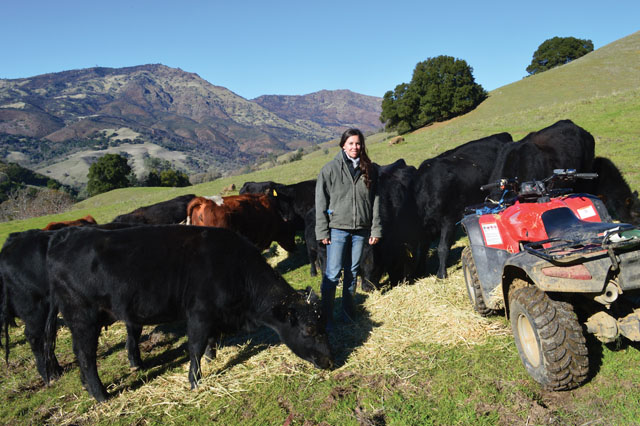
THE ECOLOGY OF A PASTURE
The conversations at TomKat are part of the growing movement to find more ways for ecologically sustainable ranching to be more economically sustainable, and vice versa. Another player in the field is Panorama Organic Grass-Fed Meats, founded in 2000 by four Northern California ranchers, including Darrell Wood. He was already respected in environmental circles for his work protecting vernal pools on his property in Northern California, populated by endemic fairy shrimp and tiger salamanders. But respect didn’t pay the bills, so he helped start Panorama to make sure grass-fed meat producers could find markets willing to pay the additional costs of going grass-fed and organic. Fifteen years later, Panorama sells to over 200 Whole Foods Markets and many smaller stores, giving ranchers in the grass-fed niche a marketing and distribution network that extends into nine states.
Panorama’s market access and ability to support the switch to organic pasture was one of the factors that attracted Greg Schmid of Los Rios Farms. Schmid and his family live in a buttercream yellow house near Winters, set back from the county road and surrounded by pasture. On a hot fall day he invites a visitor into an old-fashioned parlor, almost from another century in its sense of comfort, quiet, and tranquility.
Though a more traditional rancher than the Markegards, Schmid is similarly fascinated with “the ecology of a pasture,” he says, gazing out at one of his from a window seat. “That’s the key, the organic matter; it reflects the type of grazing that you do. The greater the organic matter, the better conditions are for everyone. Cows, wildlife, dung beetles, the whole cycle of life. There are all kinds of stories going on out there.”
Schmid’s work is “more like being a farmer than a rancher,” he says. He has ranched on native pasture and irrigated pasture, but prefers a mix of natives and nonnatives, what an ecologist would call “a novel ecosystem.” He uses a mix of plants “that the cattle think are delicious — alfalfa, clovers, annuals, ryegrass — and that will put weight on them. I use rotational grazing and move them around. If you keep cattle on a piece of land for too long, they eat and trample the vegetation to the nub, and destroy the ‘solar component’ — the leaves that capture sunlight and rebuild.”
How often he moves the cattle depends on soils, vegetation cover, and weather. “If you leave cattle on a wet pasture for too long their hooves can scar and pock the whole pasture, and when the soil dries out it gets too compacted to grow anything,” he says. Schmid moves his cattle on foot or on ATV, or sometimes, “once they know the routine,” he’ll just open a gate and say, “Here cow!”
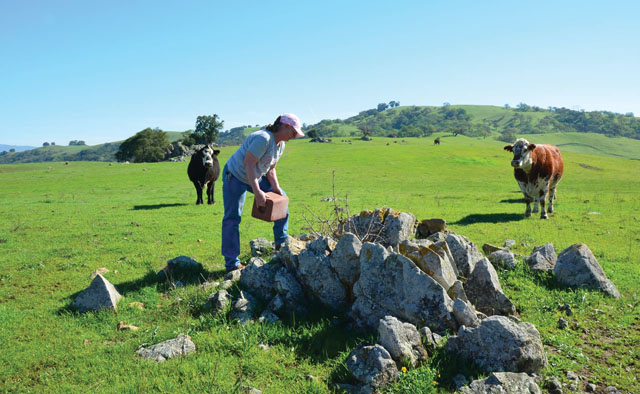
SALAMANDERS AND BUTTERFLIES
While the grass-fed niche in the Bay Area is small and growing — nationally grass-fed beef captures only 5 percent of the market — it is the traditional ranchers who also manage for sustainability that have the capacity to protect the largest and most intact swaths of the remaining rangelands. In the East Bay, Seth Adams, land conservation director of Save Mount Diablo (SMD), works on stitching together a “national park-size conservation-managed area around Mount Diablo; not state park size — national park size,” he emphasizes, with public and private land all under some form of conservation management. Adams says that SMD owns 20 properties, and “we graze most of them.” He adds, “As long as neighbors stay in ranching, I can focus on protecting properties that are being sold for development.” Adams sees ranchers as added conservation value: “Many of the ranchers I know have been here for decades and they are the best naturalists I know; they know the area like the back of their hands.” These ranchers show that holistic management is not the only path to a sustainable landscape. Traditional ranchers who have been able to stay on their ranches are attuned to forage, livestock, and ecological interactions, and they move their cattle not with electric fences but with distributed water sources and salt blocks.
Like many conservation activists, Adams only came to appreciate the role of ranchers over time. “I started working for Save Mount Diablo in 1988 and worked hard to eliminate ranching from Mount Diablo State Park. There was a big huge fight about taking grazing off the park.” But during the decades after the battle was won and the cattle were removed, Adams saw firsthand “that some landscapes benefited and some suffered, and the new science coming out supported the idea that some landscapes needed grazing.” Adams also realized that “grazing is a cheap way to manage fire fuel” as he took on the challenge of managing fire-prone areas.
One of SMD’s lessees is Carissa (Cari) Koopmann Rivers, part of the well-established Koopmann ranching family that has been recognized for environmental stewardship at their home ranch near Sunol. She is also ranch manager of Audubon’s 6,700-acre Bobcat Ranch near Winters. There, she oversees enhancements in cattle grazing and wildlife habitat. Adams says Rivers “is managing grazing using ecological principles to bring properties back to better health and she’s interested in how the ranching community continues into the next generation.” She’s raising the bar, in both her management of springs and grasses and in her ability to connect with people—and her cattle are beautiful.”
But as a young rancher, Rivers encounters formidable barriers, such as the lack of affordable grazing land. “We can’t compete with the big operators,” she says, “or bid as high as them, so if we do find ground, it’s so far away or so small that it doesn’t make sense economically because we can’t run enough cows, or it needs so much work in terms of water development, fence repair, noxious weed control, etc.”
Like her brother Clayton who works as a rangeland ecologist at the Midpeninsula Regional Open Space District, Cari also works two jobs and drives long hours to tend cattle at multiple sites in order to make a living. “From my house to Mount Diablo, it’s 68 miles. I drove about 10,000 miles in 2014 just to check on cattle, develop water, fix fences, and meet with Save Mount Diablo staff.”
One of the sites she visits is the Koopmann family ranch, located between Highway 680, a golf course, and several ranchettes, one with a helipad. Because of the area’s high property values the family was hit with a substantial estate tax bill after Cari and Clayton’s grandparents passed away. But parents Tim and Melinda Koopmann were determined to keep the ranch intact, and working with the California Rangeland Trust, they found a way to do that by selling conservation easements on parts of their ranch to protect several listed species, including the California tiger salamander. “California tiger salamanders are the most lucrative livestock I’ve ever raised!” Tim says.
Tiger salamanders aren’t the only federally listed species getting a helping hand from managed grazing. Biologist Stuart B. Weiss of Creekside Center for Earth Observation likes salamanders, but his true passion is the threatened bay checkerspot butterfly. To talk with him is to shape-shift in scale down to dirt level, a kind of “Honey, I Shrunk the Kids” vantage point that turns grasslands into a place of microfaunal jungle odysseys. For Weiss, everything about well-managed grazing programs — public or private, holistic or not — on the region’s unique serpentine soils is good news. Without cattle to crop the nonnative, annual grasses, the area would become a thatch of impenetrability, stifling for the native host plants of the checkerspot larva and impassable for salamanders and frogs. As an added bonus, the annual grasses on Coyote Ridge south of San Jose — the last major refuge for the checkerspot — absorb smog-forming gases from nearby Highway 101 and Silicon Valley; grazing by the cows helps remove tons of nitrogen from the ecosystem every year. “My haiku is: Cows graze quietly / Grasses remove smog from air / Many butterflies,” says Weiss.
Weiss has worked closely for years with nearby rancher Justin Fields, who grazes his cows on Coyote Ridge, parts of which are managed by the Santa Clara Valley Open Space Authority. It’s not only critical habitat for the checkerspot, it’s also part of a key wildlife corridor between the central Diablo Range — a huge swath of privately and publicly owned wildlands where mountain lions prey on tule elk — and the forested Santa Cruz Mountains to the west. In between, however, are the Coyote Valley and Highway 101, and if you’re a four-legged creature looking to find a mate or prey, it’s basically the mother of all corridor challenges.

THE CORRIDOR CONNECTION
Assembling a viable corridor across the Coyote Valley is the dream of Andrea Mackenzie, general manager of the Open Space Authority. “One day,” she says, “there could be a protected corridor all the way from the Diablo Range and Coyote Ridge to the east, across our Coyote Valley Open Space Preserve to the Santa Cruz Mountains on the west.”
Key to that dream is the 2,700-acre Tilton Ranch, owned by the Baird family. Janet Baird Burback’s great grandparents bought the parcel in 1917, when the valley was still wide open. Burback is a traditional rancher who also raises some grass-fed beef on the side for family and friends. Her ranch is one of the last holdouts against a tide of development sweeping south from San Jose. Because of its strategic location, Tilton Ranch is part of the area dubbed “an essential corridor link” for wildlife by the Living Landscapes Campaign of five South Bay conservation nonprofits.
But ranching is a difficult business, and Burback and her family have had to sell portions of the ranch to generate additional revenue. In the late 1980s her grandmother sold a 350-acre parcel to developers. But the development plans never panned out, and in 2010 the Open Space Authority purchased the property, which will open to the public in the summer of 2015 as Coyote Valley Open Space Preserve.
Part of the preserve’s ongoing management plan calls for leasing it to local ranchers, including Burback and Fields, reflecting the authority’s mission to preserve open space for both public recreation and agriculture. “Partnerships with ranchers like Janet and Justin are essential,” Mackenzie says. “The health of our natural landscapes and ranching are inextricably linked.”
These new alliances make Lynn Huntsinger very happy. A professor at UC Berkeley’s Department of Environmental Science, Policy, and Management, she’s been studying the intersection of ecology and ranching since 1983. “Sustaining rangeland ecosystems is as much a social process as an ecological one,” she says, “and alliances are key to creating sustainable ranchland landscapes.” She believes that “cultural differences must be overcome, so that each side begins to understand the other’s point of view. Where you can get different landowners working together across property boundaries, where the public and private lines disappear, you can support learning about the ecosystem for the common good and get conservation management taking place on a landscape scale. That’s where the magic happens.”
Huntsinger is one of more than 100 scientists, public agencies, and nonprofits who have signed up to be part of the California Rangeland Conservation Coalition. Director Pelayo Alvarez, Ph.D., says the goal is to “keep ranchers ranching.” Alvarez spoke at a state-sponsored Climate Adaptation Forum, brimming with climate activists, in late 2014. “We need to make it easy for ranchers to do the right thing,” he said, and proceeded to tick off his priorities: facilitate the permitting process; increase the amount of leasable land on state parks; and establish common conservation goals with ranchers backed up by policy, financial incentives, and technical support. “We must reduce the barriers to implementing true rangeland conservation if we are to achieve real climate resilience in the Bay Area and all of California,” Alvarez told the crowd.
When you listen to evangelists like Huntsinger and Alvarez and ranchers like Doniga Markegard and Cari Koopmann Rivers, the range of possibilities seems endless. It’s clear that a movement is growing that views well-managed rangelands as hidden assets, private lands yielding both ecologically measurable and intangible public benefits. But real hurdles remain, especially when environmental concerns and rancher needs conflict. And for the dwindling number of ranchers left in the Bay Area, there is concern about maintaining a local ranching economy large enough to support basic services like veterinarians, feed stores, truckers, and equipment vendors. Meanwhile, drought and climate change cast the longest shadows.
But ranchers in the Bay Area are a committed group, and the opportunities for innovation and collaboration are growing. With a new generation creating powerful alliances and connections with the food-conscious urban population, it makes one wonder if, like the spirit of Hank Stone, the answers to some of the Bay Area’s toughest food and environmental challenges might just be hidden in plain sight, right where the cows are grazing.
“Range of Possibilities” was produced by Bay Nature magazine, with the generous support of the California Rangeland Trust, for publication in the April-June 2015 issue of the magazine. Additional copies of this publication can be obtained by contacting Beth Slatkin, Outreach Director, at beth@baynature.org, 510-528-8550 x107.
The California Rangeland Trust, a 501(c)(3) nonprofit organization, was founded in 1998 by a group of innovative cattlemen and women, to conserve the open space, fresh air, clean water, and wildlife habitat provided by working lands. Using conservation easements, the Rangeland Trust has protected 283,000 acres of privately owned rangeland throughout the state. For more information and to see videos of Rangeland Trust ranchers, visit rangelandtrust.org.



